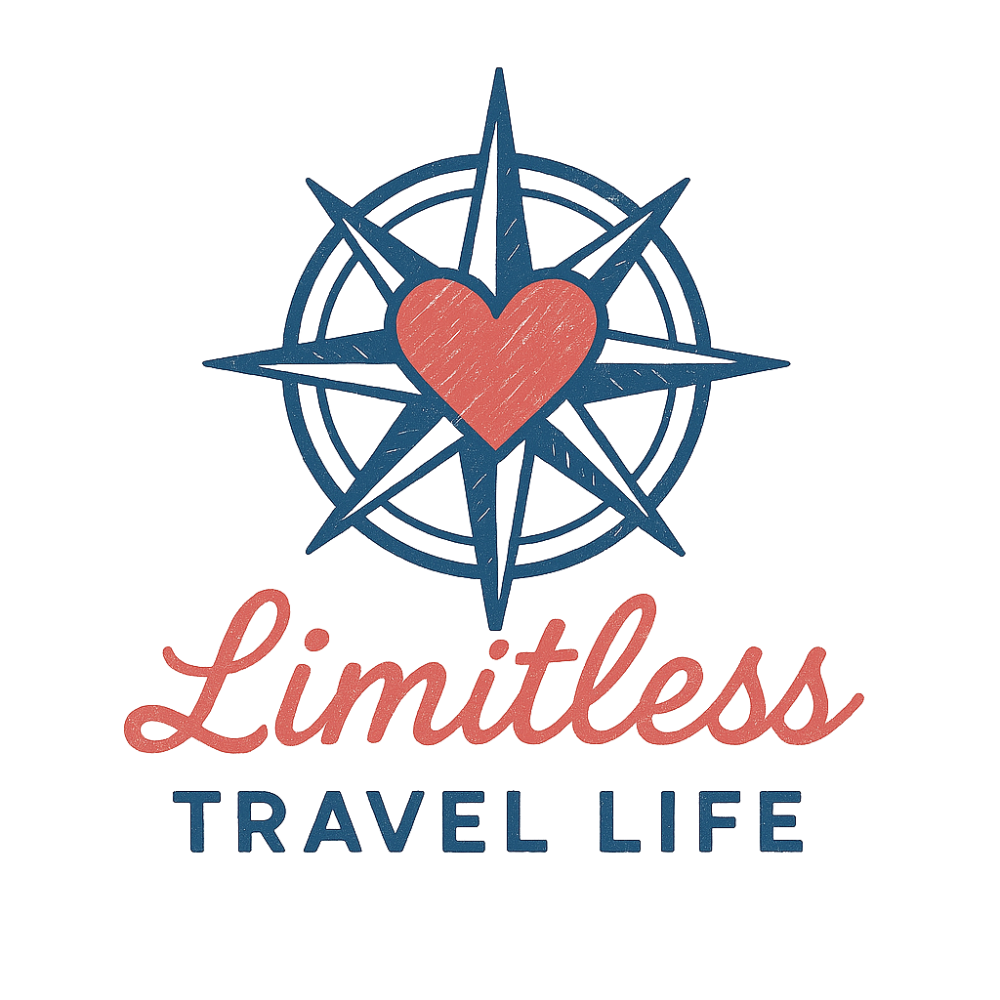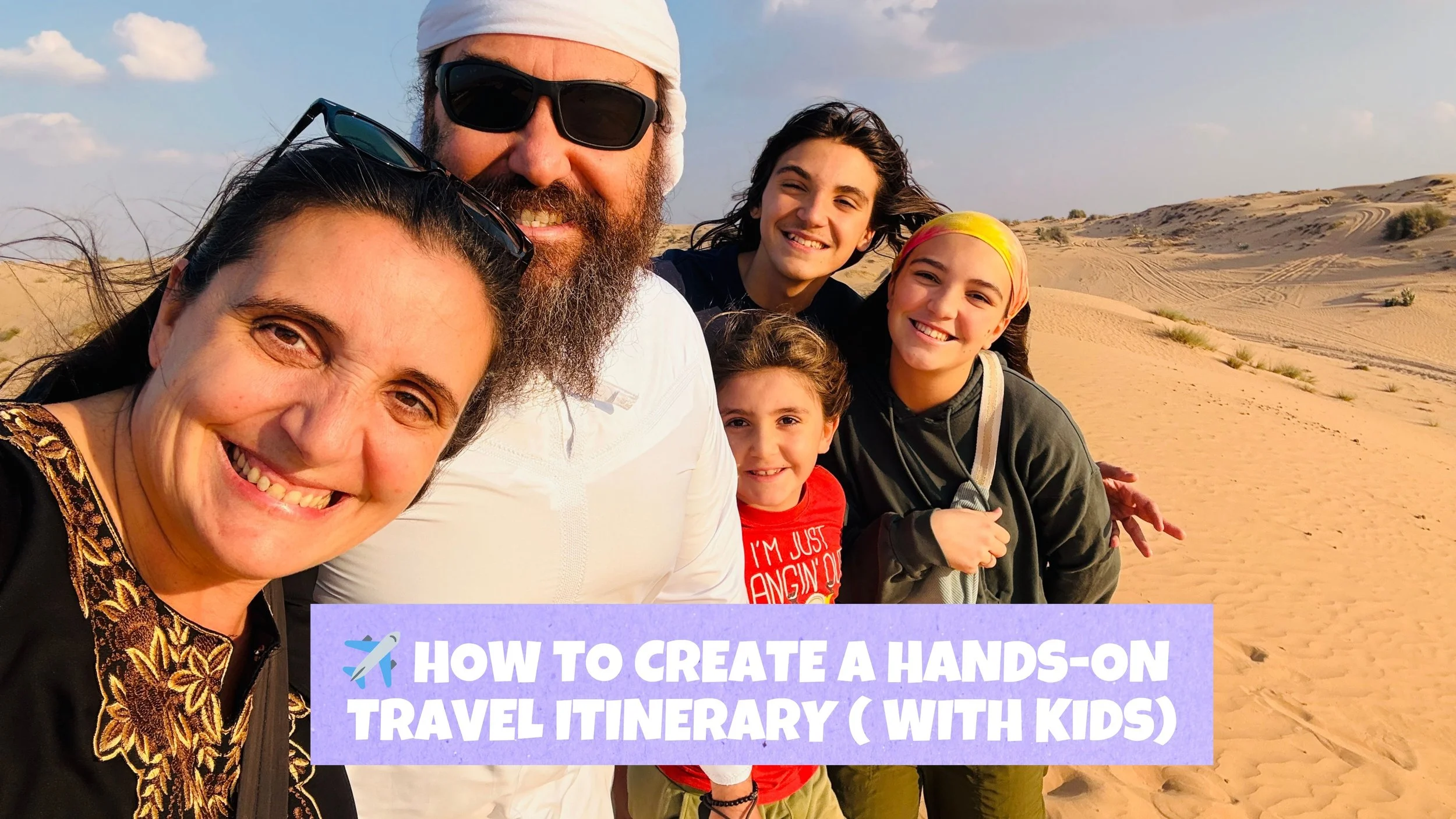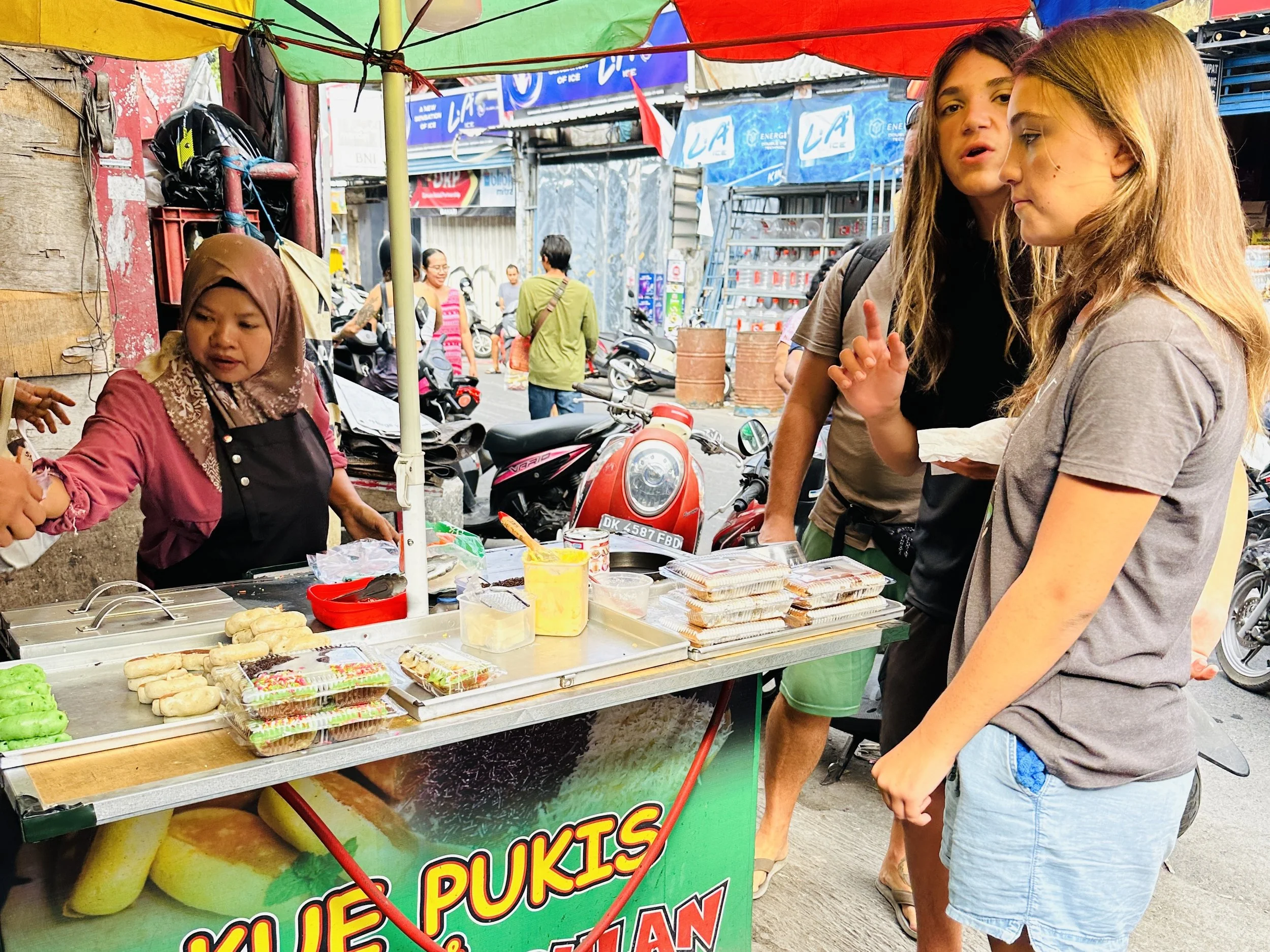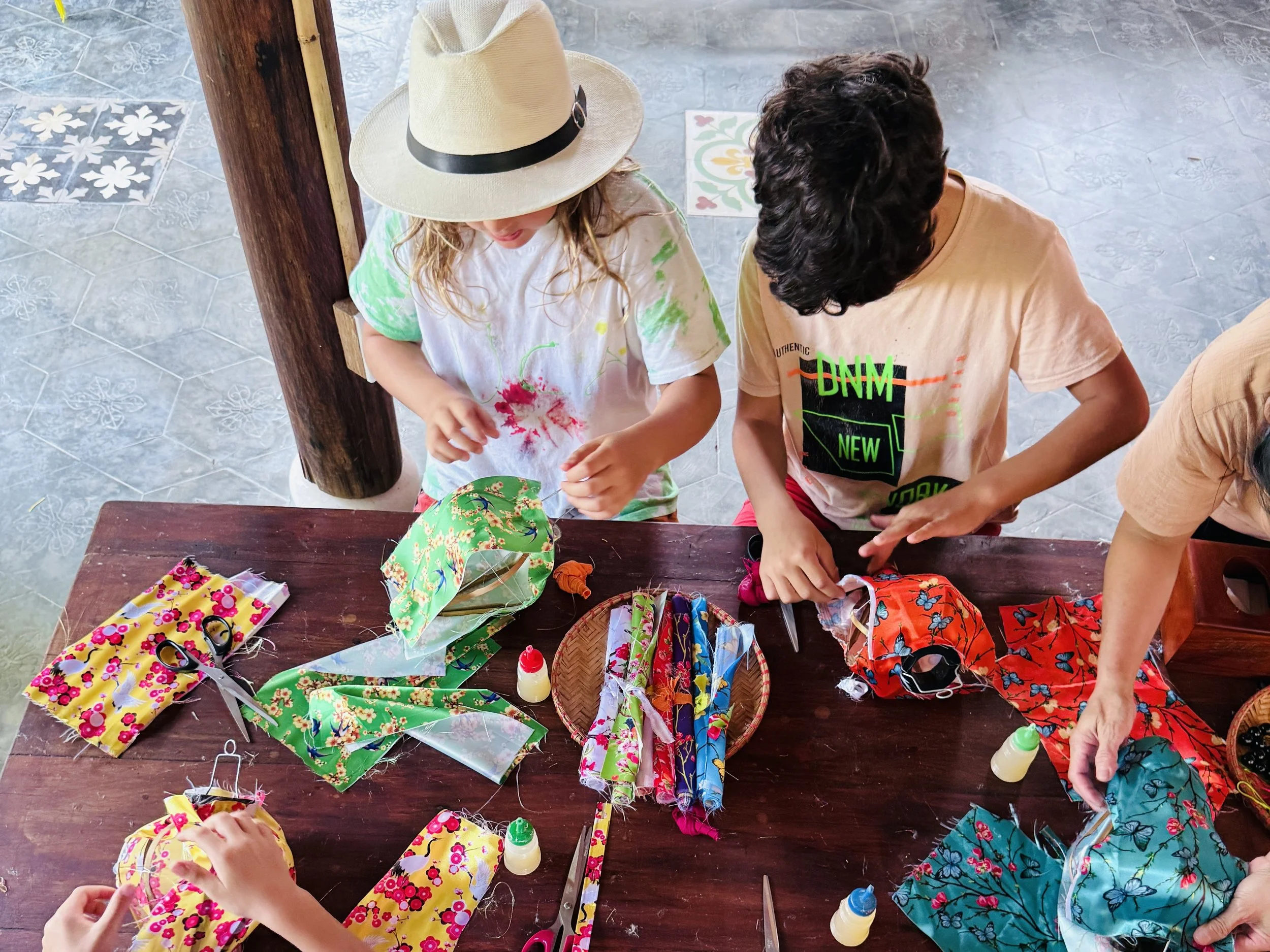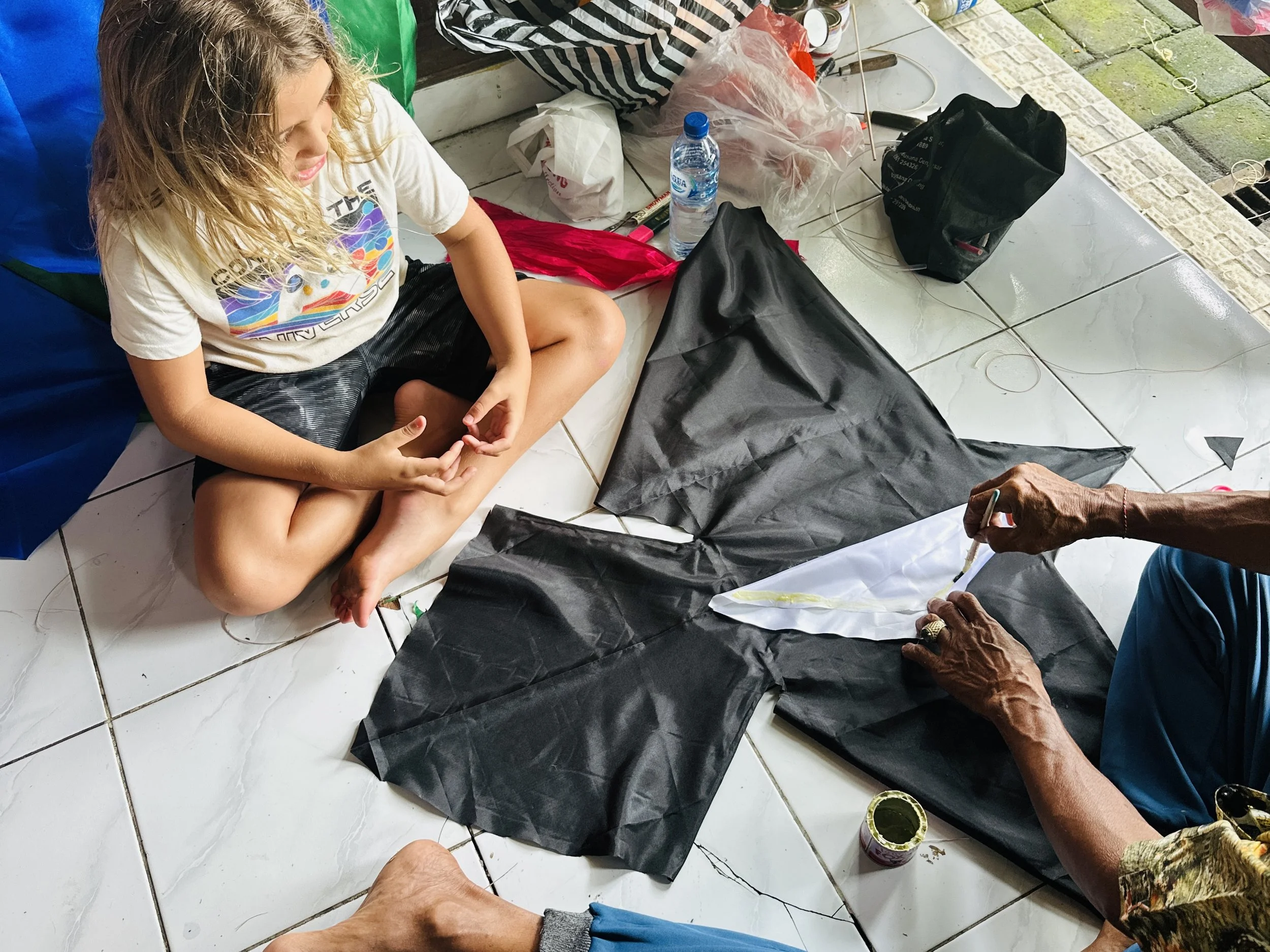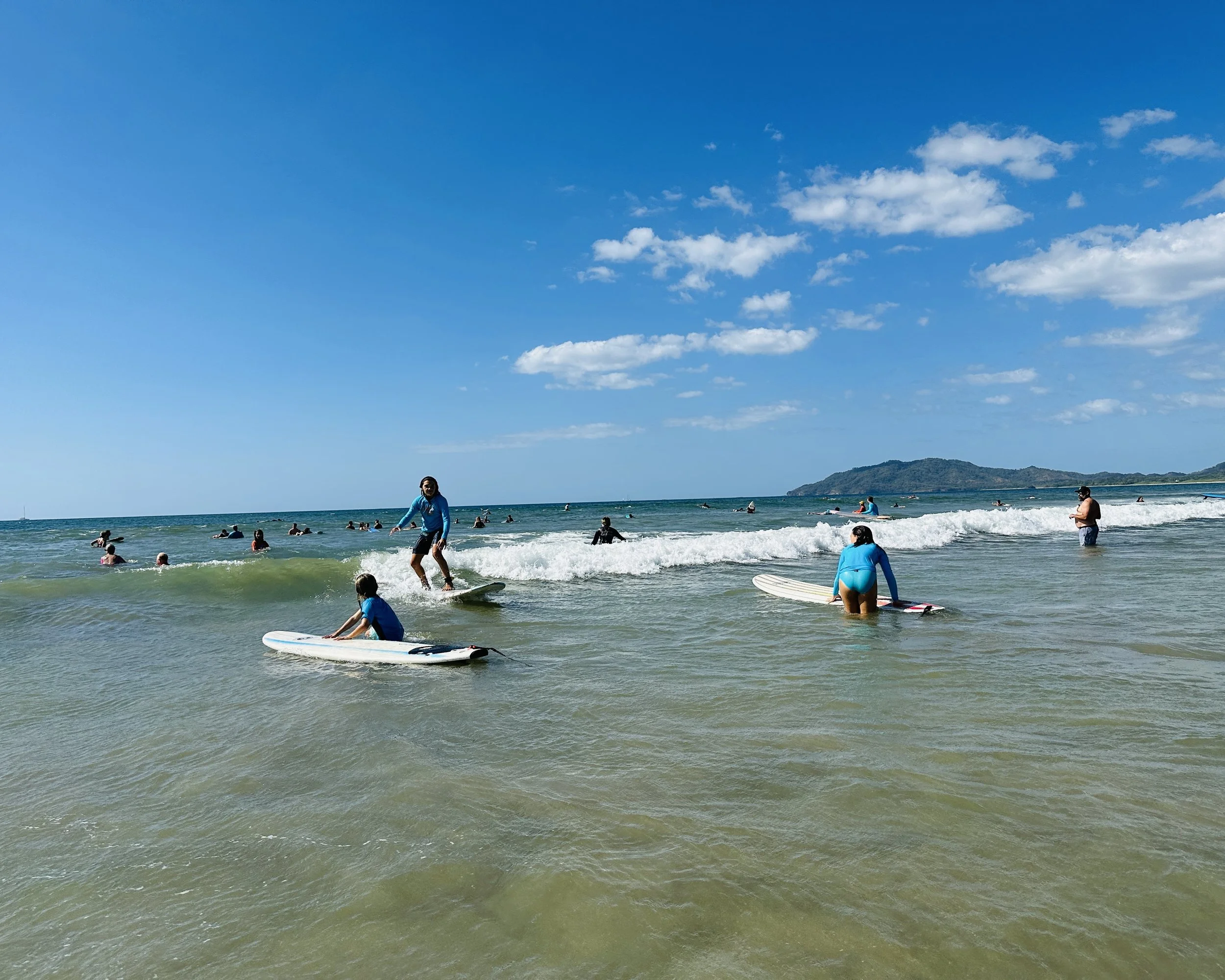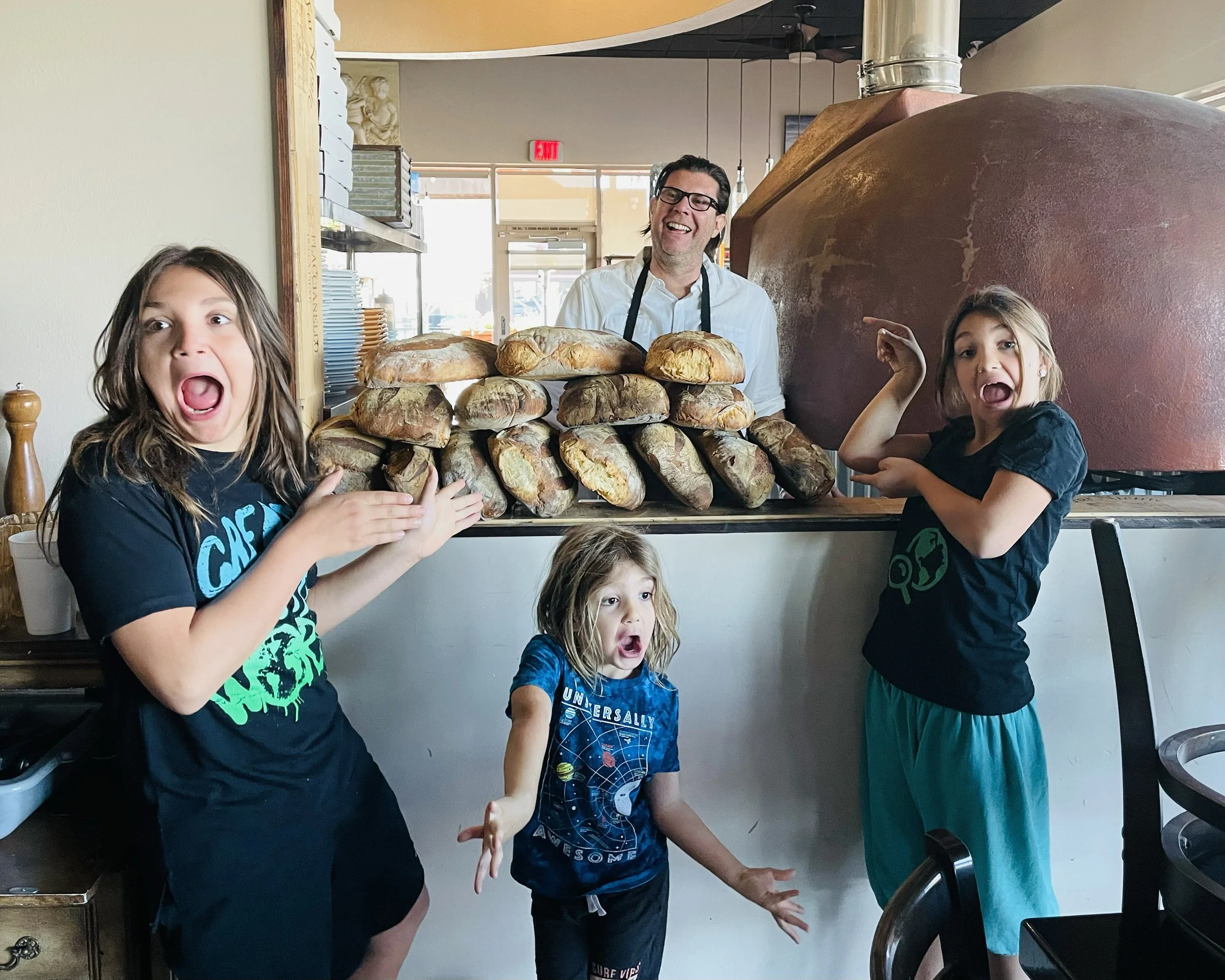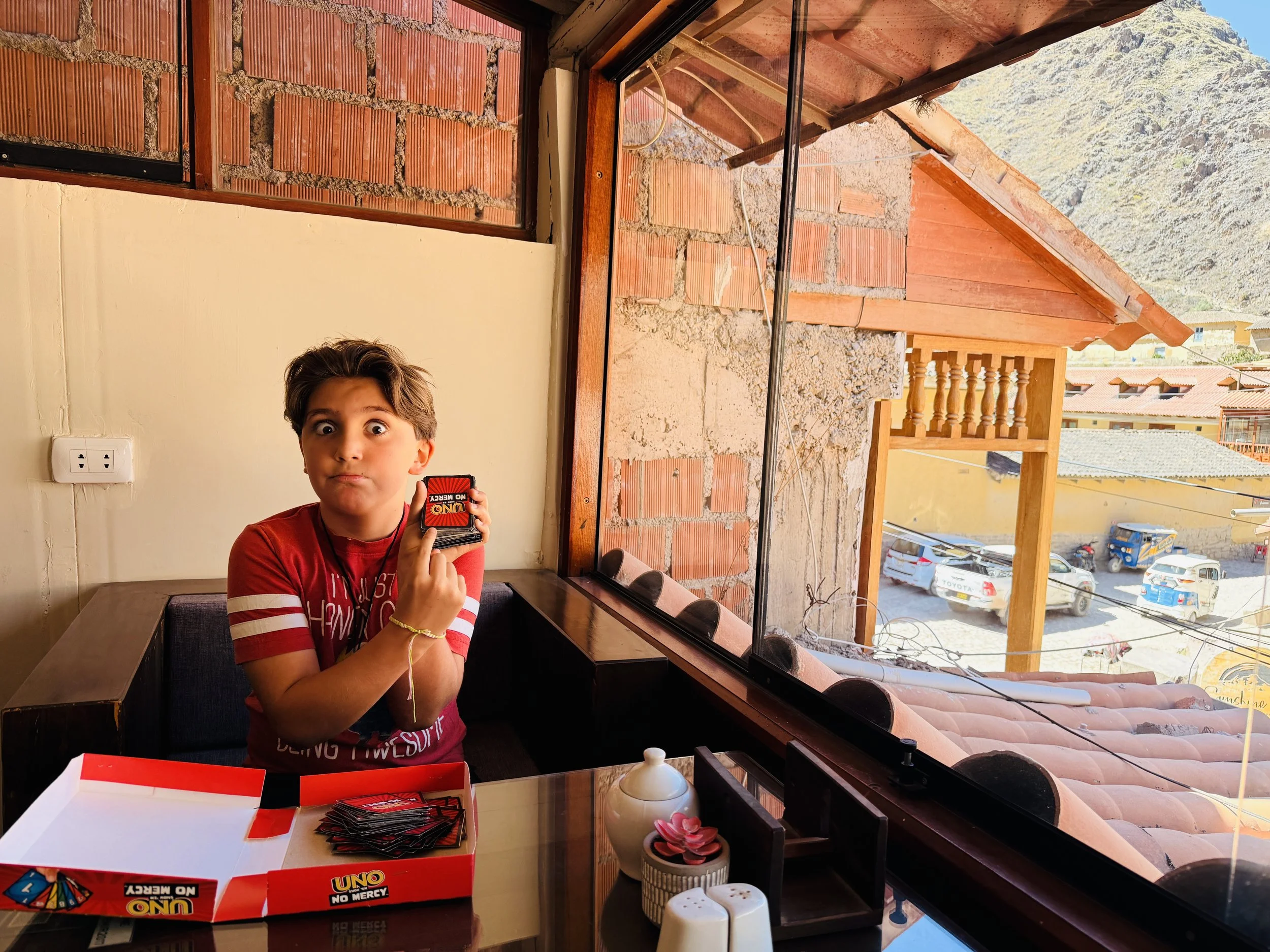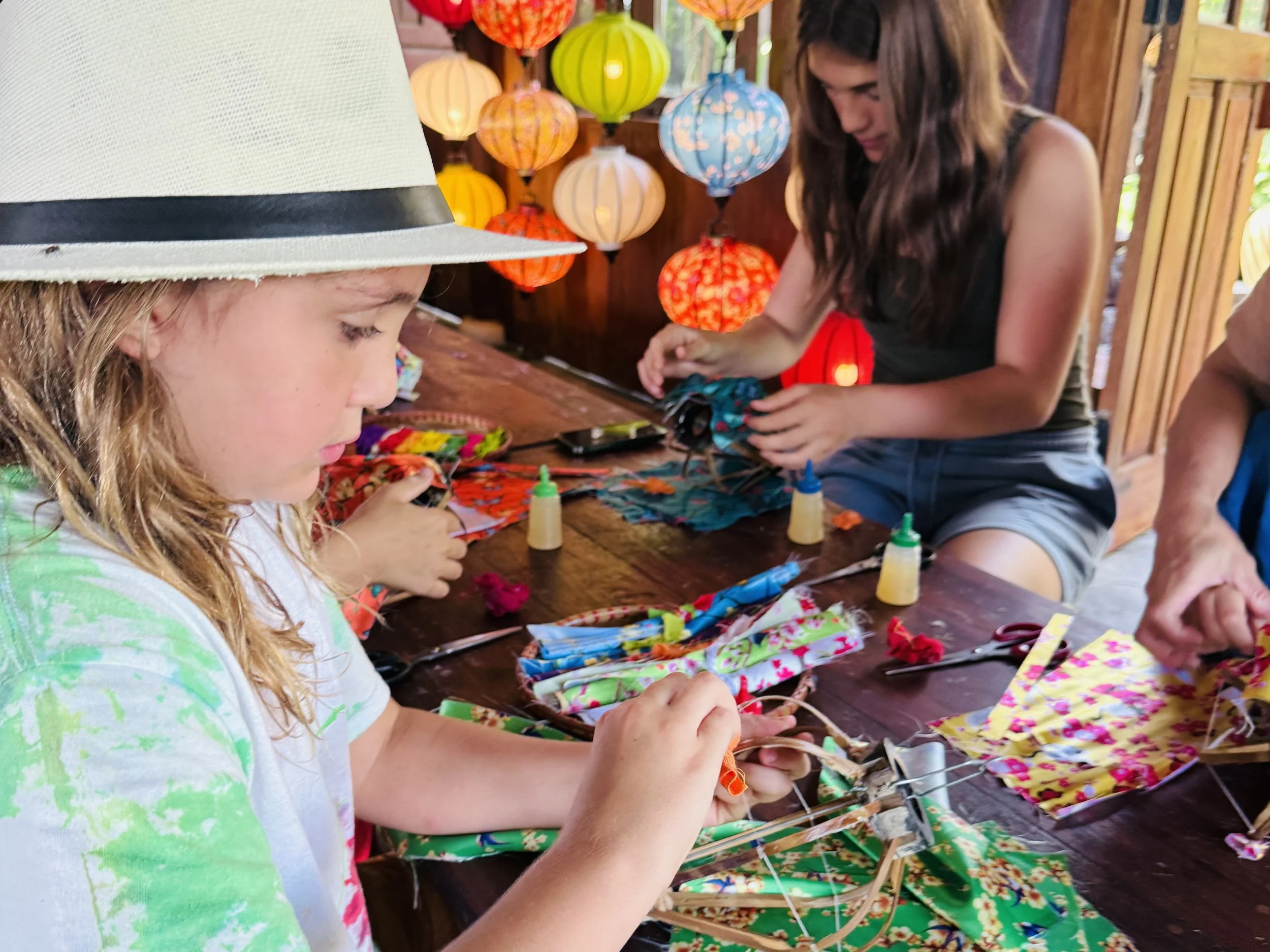✈️ How to Create a Hands-On Travel Itinerary (Especially with Kids)
The most meaningful travel moments don’t come from seeing a place — they come from doing something within it. Over the years, our family has learned that hands-on travel — cooking with locals, creating, learning, and connecting — turns trips into lifelong memories. In this post, we share how we keep our adventures immersive and spontaneous, and how you can bring that same curiosity and connection into your own travels, whether you’re on the road full-time or exploring for a week.
Travel has always been about discovery: new sights, flavors, and ways of life. But over the years, we’ve realized that the most meaningful moments don’t come from simply seeing a place; they come from doing something within it.
When we first started traveling full-time as a family, our itineraries were packed with must-see landmarks and top-rated attractions. We checked them off one by one, proud of how much we had covered. But something was missing: a sense of connection.
It wasn’t until we slowed down and began engaging with the local culture that travel started to feel truly transformative. When our journeys stopped being about ticking things off a list and instead became about opening ourselves to unexpected opportunities along the way, everything changed.
That’s when we discovered the power of the hands-on travel itinerary: one that turns a trip into an experience and transforms sightseeing into lifelong learning.
In this post, we’ll share how you can create your own hands-on itinerary, especially if you’re traveling with kids. These are the strategies, tools, and mindset shifts that helped us turn our family adventures into immersive, memorable journeys, the kind your children will still talk about years later.
🌍 What Is a Hands-On Travel Itinerary?
A hands-on travel itinerary focuses less on observing and more on participating. It’s about rolling up your sleeves, engaging your senses, and connecting with local people through shared experiences.
Instead of just watching a dance performance, you learn the steps.
Instead of buying handmade pottery, you sit with the artisan and mold the clay yourself.
Instead of walking through a market as a tourist, you cook a meal with ingredients you picked out that morning.
This approach makes every destination come alive, especially for children. Kids naturally learn through play, touch, and participation. When they can do something, they don’t just remember it; they understand it.
A hands-on itinerary might include:
Cooking or craft workshops with locals
Nature-based experiences like farming, animal care, or foraging
Cultural rituals or ceremonies (observed respectfully and sometimes participatory)
Learning activities such as language classes, art, or storytelling
Community engagement, like volunteering or helping at a local school or project
It’s travel that blends learning, connection, and fun, a combination that makes even the smallest experiences unforgettable.
👨👩👧👦 Why Hands-On Travel Works So Well for Families
We often joke that kids are the best travelers because they’re curious by nature. They ask questions adults would never think of, notice tiny details, and dive in without hesitation.
In 2019, we were visiting a winery in South Africa. Cosimo was genuinely curious about how wine was made and insisted on joining the whole tour of the winery. Since Emma and Luca preferred running around the open fields, we decided to split up so everyone could experience the place in their own way.
Throughout the tour, Cosimo stayed right up front, asking one thoughtful question after another. The guide later told us how much he enjoyed having him there because his curiosity made the entire experience more engaging, not just for us, but for all the adults on the tour.
That’s precisely what hands-on travel nurtures: that natural spark of curiosity that makes learning effortless and exciting.
Here’s why it’s such a powerful approach for families:
1. It Keeps Everyone Engaged
Extended museum visits and endless walking tours can test anyone’s patience, especially kids. But give them the chance to knead dough, paint a mask, build a kite, or plant a seed, and suddenly they’re all in.
One of our favorite experiences was a lantern-making workshop in Hoi An, Vietnam. Our kids chose the fabric they liked, glued, and assembled their lanterns. They didn’t just make a souvenir; they learned about the meaning of lanterns in Vietnamese culture, about patience, and about working together as a team.
2. It Turns Learning into Living
Travel is the best classroom, and hands-on experiences make it even richer. Kids learn geography, history, and culture naturally, without worksheets or lectures.
A day spent learning to make coffee in Costa Rica taught our kids about local agriculture, trade, and even the global impact of small farms. They saw the process from bean to cup and, through touch and taste, understood how much effort goes into every sip.
These moments teach lessons that stick, not because they were studied, but because they were lived.
3. It Builds Confidence and Connection
When children learn new skills abroad, they see themselves differently. They realize they can adapt, communicate across cultures, and try new things without fear. That confidence carries over into daily life.
We’ve seen our kids go from shy to self-assured after guiding others in a local art workshop or sharing what they learned about cooking spices in a Thai kitchen. These are the kinds of experiences that help them grow not just as travelers, but as people.
🧭 How We Keep Our Travels Hands-On (Even When We Don’t Plan It)
When you travel full-time, you can’t plan every detail, and honestly, that’s the beauty of it. Some of our best experiences happened because we were open, curious, and willing to say yes in the moment.
Over time, we’ve found a rhythm that keeps our travels naturally hands-on. It’s less about building itineraries and more about cultivating awareness, recognizing meaningful opportunities when they appear.
1. We Follow Curiosity, Not Checklists
Instead of researching everything ahead of time, we let our surroundings and interests guide us.
If we meet a local who mentions a festival, a family craft, or a small business, we follow that lead.
That’s how we ended up learning to make chocolate in Peru, build kites in Indonesia, and make pottery in Nepal.
Hands-on travel isn’t about searching; it’s about noticing what’s right in front of you.
2. We Let the Kids Lead
Our kids’ curiosity is often our compass. When one of them becomes fascinated by something, whether it’s coffee beans, temple bells, or surfboards, we pause and explore it further.
In Costa Rica, for example, our kids asked to take surfing lessons. We booked a house in Tamarindo, an excellent spot for beginners, and dedicated some time to learning surfing there. Their excitement and progress reminded us how much joy comes from letting their interests shape our plans.
When children guide the day, learning happens effortlessly. Those moments often become the most memorable because they’re born from genuine interest, not parental planning.
3. We Look for People, Not Tours
Instead of booking big, packaged experiences, we look for personal connections.
We’ve met artisans, farmers, and cooks who were happy to share their craft simply because we showed interest.
Sometimes all it takes is asking, “Can you show us how you do that?” and suddenly, you’re part of an authentic exchange of culture and kindness.
However, when we do join tours, we prefer small or private groups, which helps our kids feel more engaged and makes the experience far more personal.
4. We Balance Doing with Being
Even hands-on experiences need space to breathe. Some days are full of activity; others are about slowing down, no plans, maybe wandering around, or just talking about what we’ve learned.
If you pack your days too tightly, everything blends, and you miss the chance to absorb each experience truly.
During our trip to Bolivia, for example, we spent three intense days exploring the Salt Flats. Once we returned to La Paz, we took a few days to rest, stroll through the city, and reflect. That’s when the genuine appreciation for those wild days really sank in.
We’ve found that reflection time helps transform experiences into a deeper understanding.
5. We Stay Longer — But You Don’t Have To
One of the most significant gifts of traveling full-time is having the freedom to slow down. The longer we stay in a place, the more life opens up. We stop being visitors and start becoming part of the rhythm.
When you stay for a few weeks or months, neighbors begin to recognize you, shop owners greet you by name, and experiences come to you naturally. You’re not chasing activities, you’re living them.
We’ve been invited to birthday parties, family dinners, and even small village festivals simply because we were around long enough for those connections to form.
But even if you only have a week or two, you can still travel with that same mindset.
Instead of trying to fit in as many destinations as possible, choose fewer and go deeper.
Spend an afternoon in one neighborhood instead of visiting three.
Return to the same café every morning and start a conversation.
You can take part in one local activity that genuinely excites you, not ten that fill the time.
While in Ollantaytambo, Peru, Luca and I were there for only three days, but we always went to the same café to play a board game and order his favorite crepes. By day two, the lady working there greeted us warmly and chatted with Luca every time. We never tried another café because we felt at home there.
Hands-on travel isn’t about how long you stay, it’s about how present you are while you’re there. When you slow down enough to engage, even briefly, you create space for the kind of magic that only happens when you connect
6. We Keep Our Days Flexible
Hands-on travel doesn’t fit into rigid plans.
We leave gaps in our days and weeks so that when something spontaneous arises —a celebration, a class, or an invitation —we can say yes.
Our amazing train ride from Cusco to Lake Titicaca happened only because I hadn’t booked any flight out. Since there was limited availability, I adapted to the one day left, and it turned out to be one of our most memorable journeys!
Flexibility has led us to unforgettable experiences that no itinerary could have predicted.
7. We Treat Every Place Like a Classroom
Whether we’re in a big city or a small village, we try to find what each place can teach us. Sometimes it’s history, sometimes it’s art, sometimes it’s resilience.
The world is full of teachers; they don’t all work in schools.
Learning happens every day in the most unexpected ways. Sometimes it’s something someone says; other times it’s something you notice while walking around.
Learning is always right in front of you; you have to be open enough to recognize it.
💡 Tools and Resources to Help You Plan
Here are a few of our favorite ways to research and organize hands-on travel experiences:
Airbnb Experiences: Great for finding small, authentic workshops led by locals.
GetYourGuide: Ideal for structured family-friendly experiences, often with clear reviews.
Viator & Klook: Useful for comparing prices and options across regions.
Local Tourism Websites: Many smaller towns have event calendars or artisan directories.
Facebook Groups: Search “[destination] with kids,” “local experiences,” or “cultural workshops.”
Google Maps Reviews: Try searching keywords like “workshop,” “class,” or “cultural experience” directly in the map.
And don’t forget, sometimes just walking around and chatting with locals reveals the best surprises.
✨ The Real Meaning of Hands-On Travel
Hands-on travel changes the way you see the world, and yourself. It’s about approaching each day with openness and curiosity.
It reminds us that learning doesn’t only happen in schools or museums, but also in kitchens, workshops, markets, and fields.
For families, it becomes a shared adventure of discovery. You learn together, make mistakes together, and grow together. You see your kids light up when they realize they can connect across language and culture, not through words, but through doing.
When we travel this way, we bring home more than souvenirs.
We bring stories, friendships, skills, and a sense of belonging that stretches across continents.
That’s the beauty of a hands-on itinerary: it transforms travel from something you consume into something you create.
Because when you roll up your sleeves, touch the world with your hands, and open your heart to what unfolds, travel stops being just a journey.
It becomes a way of life. 🌍
Wishing you all Happy travels!
Why We Prioritize Experiences Over Destinations (And How You Can Too)
After years of full-time family travel, we’ve discovered that the real magic doesn’t come from checking off landmarks; it comes from the experiences that connect us to the people, culture, and spirit of a place. From cooking Khmer curry in Cambodia to drifting along the Mekong in a sampan boat, it’s these immersive moments that have shaped our journey the most. In this post, I’m sharing how shifting our focus from destinations to experiences transformed our travels and how it can do the same for yours.
Let’s be honest...
Most travelers plan their trips around a place:
“We’re going to Paris!”
“Let’s see Machu Picchu!”
“Tokyo is on our bucket list!”
But after years of full-time travel as a family, we’ve learned that the true magic doesn’t come from checking off destinations.
It comes from what you do when you’re there.
From making fresh spring rolls in Cambodia to sandboarding in the Peruvian desert, our most memorable moments come from experiences that connect us to people, culture, and nature, not from landmarks.
Here’s why we’ve shifted from chasing places to seeking experiences and how that simple mindset change has transformed our travels.
Dune surfing in Huacachina, Peru
1. It Started With One Unexpected Moment
When we first started traveling full-time, I had a checklist packed with famous sites we had to see. We rushed through museums, monuments, and “top 10” attractions, trying to squeeze in as much as possible.
Then the pandemic hit, and we found ourselves stuck in Nepal. During that unexpected pause, something shifted. We had the chance to interview a local artist for our YouTube channel (AMAR SHAKYA, PAUBHA ARTIST in Nepal. People we meet), and in the process, he offered to teach our kids his artistic techniques. A few days later, we also interviewed our hosts, who gave us a place to stay for a reasonable price the night before Nepal went into lockdown (COSY NEPAL in PATAN, Nepal. People we meet), and that’s when everything changed.
That’s where we found a real connection.
That’s where we discovered the true inspiration behind our travels.
It wasn’t about checking off landmarks anymore.
It was about slowing down and connecting, on a deeper, more meaningful level, with the people and culture around us.
That was our turning point. We realized the moments we remember most aren’t the biggest or most famous, they’re the ones where we engage, share, and genuinely feel where we are.
2. Cambodia: From Street Food to Circus Magic
Let me give you a more recent example. When we visited Cambodia a few months ago, we naturally marveled at Angkor Wat and spent time exploring the temples.
But what we really remember is making Khmer curry together during a local cooking class in Siem Reap. After picking up our ingredients at the local market, we were welcomed into a small open-air kitchen. Our teacher showed us how to grind spices by hand, cook over an open fire, and finish our dishes with delicate banana leaf flowers.
The kids were so proud of what they made, especially Luca, who almost burned himself while enthusiastically stirring the meat in the pan. Despite the near mishap, we all finished every bite with big smiles.
That evening, we attended the Phare Circus, an incredible performance blending storytelling, acrobatics, and music. What made it truly unforgettable was learning that the performers were all young people from disadvantaged backgrounds, trained through a social arts school. The show wasn’t just entertaining, it was profoundly moving. I found a ticket option on Viator that allowed us to go behind the scenes, and it gave all of us a much greater appreciation for the effort, passion, and dedication these artists pour into their craft. It left a lasting impression on every one of us.
A beautiful moment also occurred backstage. As we watched the artists prepare, Mass noticed a therapist massaging one of the performers who seemed to be in pain. With his background in physical therapy, he offered to help. The therapist welcomed his support, and within minutes, the artist began to feel better. Soon, more performers began lining up for a quick check-up from Mass. It turned into a spontaneous collaboration, and what struck us most was how open and grateful everyone was. The therapist didn’t feel threatened; she just felt relieved to have extra help healing her team. That moment revealed a great deal about the values of this culture: community, humility, and care for one another, without ego or competition.
Those two experiences, cooking and the circus, offered more cultural understanding than any guidebook or history tour ever could.
And while we found these activities online (some through Viator, others through local tips), what mattered most wasn’t how we booked them, but how they made us feel.
Phare Circus group shot in Siem Reap, Cambodia
3. Vietnam: Lanterns, Sampans, and Slow Moments
Vietnam gave us so many sensory memories: the scent of fresh herbs, the buzz of scooters weaving through the streets, and the warmth of the people everywhere we went. But two experiences stood out above the rest.
In the charming town of Hoi An, we took part in a traditional lantern-making workshop. Surrounded by silk fabric, bamboo frames, and excited chatter, our kids created their lanterns from scratch. The process was calming and almost meditative. We carefully glued the fabric, bent the frames, and chose colors that reflected our personalities.
The kids were entirely focused, and by the end, each of them proudly held a handmade lantern, a small piece of Vietnam that we had shaped with our own hands, and was coming home with us.
Later in the trip, we headed south to the Mekong Delta, where we climbed into a small wooden sampan boat, made home for a few nights, and quietly glided through narrow canals. Everything slowed down. The only sounds were the gentle rhythm of the river, children splashing and laughing in the water, and the occasional passing boat loaded with rice, fish, or bricks, products of life lived along the riverbanks.
It was peaceful, even for our kids, who usually aren’t fans of “slow.” But something about being rocked by the current and witnessing everyday life along the Mekong calmed us all. There was no rush, no loud noise, just stillness, simplicity, and presence.
That boat ride wasn’t thrilling in the typical sense, but it offered us a quiet, powerful connection to the land and the people, a connection that’s hard to put into words and impossible to forget.
These two moments, crafting lanterns and drifting through the Mekong, reminded us just how powerful simple, hands-on experiences can be. They slowed us down and pulled us into the heart of Vietnamese culture in a way that no big-city tour ever could.
5. What Happens When You Travel for the Experience
When we focus on doing rather than just seeing, something shifts:
We connect with the people who live there
We learn about daily life, culture, and values in a hands-on way
We remember the trip more vividly and longer.
Our kids stay engaged because they’re part of the action
We return home changed, not just rested.
6. How to Start Prioritizing Experiences Over Destinations
You don’t have to overhaul your entire travel style; shift your focus a bit. Here’s how:
🧭 Ask Different Questions
Instead of: What’s the top place to visit in this country?
Ask: What do we want to experience, feel, or learn while we’re here?🔍 Look for Local-Led Opportunities
Cooking classes, artisan workshops, food walks, farm visits, and storytelling events all offer a glimpse into real life.
We often use a combination of online platforms (such as Viator or GetYourGuide), local Facebook groups, and personal recommendations to find these.
👨👩👧👦 Let the Kids Pick
Ask your kids what they want to try: climbing, dancing, building, painting, eating, and let their curiosity lead.
⏳ Leave Room for Discovery
Don’t overbook every day. Some of our best experiences happened when we slowed down or had “open” afternoons.
7. But What About the Famous Stuff?
Of course, we still visit famous places! We’ve stood in awe at the Taj Mahal, explored the temples of Angkor Wat, and even gone up the Eiffel Tower, twice!
But instead of racing through 10 sites in 3 days, we choose fewer places and go deeper.
When we visit iconic landmarks, we look for ways to make the experience more personal and meaningful. That might mean:
Hiring a local guide to share stories and history beyond the surface
Booking an experience that helps us better understand the local culture
Letting the kids engage in their way, through questions, photos, video, or simply quiet observation
These small shifts turn famous sights into lasting memories.
They’re no longer just photos in a camera roll, they become part of our shared story.
8. Why This Matters (Especially for Families)
When traveling with kids, attention spans, energy levels, and moods are crucial.
They’re not likely to remember a monument, but they will remember making something, tasting something, or talking to someone.
Experience-first travel:
Builds empathy
Sparks curiosity
Strengthens family bonds
Feels more human
It’s not just about what you see. It’s about what you feel together.
9. What I’ve Learned from Planning Our Adventures
After traveling full-time since 2018, I’ve had my fair share of trial and error when it comes to planning meaningful trips for our family. I’ve learned that it’s not just about where you go, it’s how you experience it. And honestly, the most memorable moments usually aren’t the ones that take the most planning, they’re the ones that feel the most authentic.
Over time, I’ve found a rhythm in how I research and choose activities. I start by thinking about what we’re curious about, what could help us understand the place, or connect with the people who live there. Then I look for experiences that feel aligned with that, whether it’s a cooking class, a street food tour, a hands-on workshop, or a slow boat ride through nature.
I’ve also learned to balance cultural exploration with fun and downtime, especially when spending time with kids. When I find something that works well for us, I love sharing it with other families who are trying to create their meaningful adventures.
Lately, I’ve discovered many great experiences through Viator; it’s been a helpful resource for finding locally led activities that are easy to book, especially in unfamiliar places. But no matter how we see them, it’s the feeling they give us that matters most.
If you’re trying to plan something that goes beyond the typical tourist trail, know that you don’t have to overcomplicate it. Start with curiosity, leave room for spontaneity, and let connection lead the way.
Final Thoughts
Where you go does matter, but what you do while you’re there matters even more.
Traveling for experiences doesn’t mean skipping the Eiffel Tower or Machu Picchu.
It means slowing down, asking questions, meeting people, and finding the joy in the little things.
So next time you plan a trip, ask yourself:
👉 What experience do I want to come home remembering?
Chances are, it won’t be a selfie in front of a monument; it’ll be the moment your kids tried something new, or the conversation you had over a meal you helped cook together.
Let those be the moments that define your travels.
